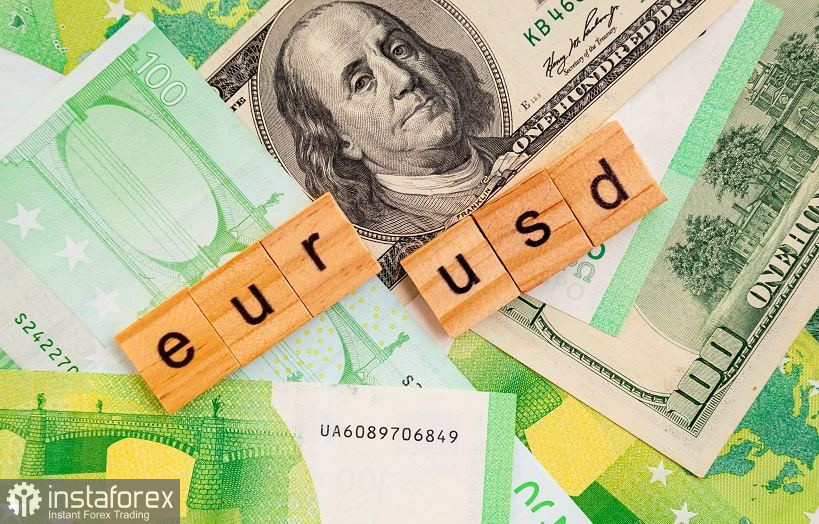The euro-dollar pair at the start of trading again demonstrates a bearish mood. During Monday's Asian session, traders tried to develop corrective growth but failed: just an hour after the opening of trading, the bears seized the initiative and sent the price to the base of the 7th figure, updating the two-year price low. The downward trend is still in force, so it is advisable to use any corrective pullbacks as an excuse to open short positions.

Even Emmanuel Macron's convincing victory in the French presidential election did not help the European currency. In the second round, 58% of the country's citizens voted for him, while 41% of French voters voted for Marine Le Pen. This result is a historical indicator for the far-right in France. In a sense, a certain danger has passed for the euro, given the intentions that Le Pen declared in her program. In particular, she advocated the restoration of the primacy of French law over European law, through the transformation of the European Union into a Union of Nations (which will not be covered by a single legislative field). If we talk about shorter-term goals, Le Pen planned to reduce France's contribution to the overall European budget by at least 5 billion euros.
However, traders actually ignored Macron's victory. This was partly due to the fact that a few days before the second round, he held a fairly successful television debate with Le Pen – the sympathies of the majority of the French turned out to be on the side of the incumbent president. Therefore, his final victory was largely predetermined and taken into account in the prices.
Traders also ignored another fundamental factor that could hypothetically support the euro. On Monday, Reuters reported that the majority of the members of the European Central Bank look forward to the early completion of the stimulating asset purchase program and the beginning of an increase in interest rates. According to reports, the rates may be raised in July. ECB Governing Council members Luis de Guindos and Martins Kazaks publicly spoke in favor of this scenario. According to Reuters sources, the "latest" date for raising rates is September.
Despite such a hawkish message, the euro remained under significant pressure. It is likely that a key role in this was played by ECB President Christine Lagarde, who last week demonstrated by no means hawkish intentions. Traders, apparently, trusted the official position of the head of the ECB, while ignoring the reports from Reuters.
All this suggests that the European currency is in a wounded position and is not capable of its own game.
Meanwhile, the greenback continues to gain momentum. The US dollar index has already reached 101.640 today (a two-year high), reflecting the increased interest of traders in the US currency throughout the market. The dollar is growing on hawkish expectations, ahead of the Fed's May meeting, which will be held next week.
Tens days prior to the meeting, representatives of the Federal Reserve are prohibited from expressing their position publicly. But many of them made their intentions quite clear last week. It's no secret that the regulator plans to raise the interest rate on May 4 by 50 basis points. St. Louis Fed President James Bullard even offered a 75-point increase, but the Fed seems not ready to implement such drastic measures yet. But at the same time, the central bank may raise the rate by 50 points at the June meeting, and, according to some data, at the July meeting. A series of 25-point increases will follow.
It should also be recalled that, according to the minutes of the Fed's March meeting, the regulator plans to begin (most likely in June) a quantitative tightening program, gradually increasing the volume of balance sheet cuts to 95 billion per month. Of these, 60 billion will fall on Treasury bonds, and 35 billion on mortgages. This is quite a "sporty pace" of the reduction of the central bank's balance sheet, if compared with the period 2017-2019.
In general, the majority of Fed representatives over the past two to three weeks have voiced hawkish theses, stating that they are ready to act "more aggressively" in response to the jump in inflation indicators. Even Governor Lael Brainard has joined the hawkish wing of the Fed, who earlier this year opposed early stimulus curtailment.
Geopolitics also provides background support for the dollar. Negotiations between Russia and Ukraine have finally stalled: the parties are not ready to announce even the approximate dates of the next face-to-face meeting. There is no question of concluding any comprehensive agreement - at least for today. According to media reports, the negotiators are still far from reaching the finish line, although the legal subgroups are still working, that is, the negotiation process has not been stopped de jure.
The tension around the Taiwan issue is not decreasing either. Recall that China decided to conduct comprehensive military exercises near Taiwan in response to the visit of US delegates to the island. Belligerent messages from Beijing continue to keep traders on their toes, allowing dollar bulls to skim the cream by strengthening anti-risk sentiment.
Thus, short positions on the EUR/USD pair are still relevant. At the moment, the bears are trying to gain a foothold below the 1.0750 support level, which they were able to break through at the start of the European trading session. If they can stay in this price area, then the next price barrier will be the 1.0700 mark, followed by an exit to the 1.0670 support level (the lower line of the Bollinger Bands indicator on the weekly chart). If EUR/USD buyers manage to organize a counterattack due to profit-taking by sellers, then in this case it is also advisable to consider sales when corrective impulses fade. The downward targets are 1.0750, 1.0700, and 1.0670.





















